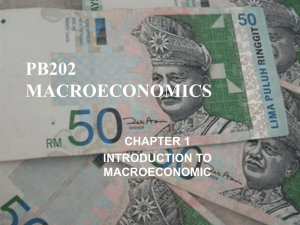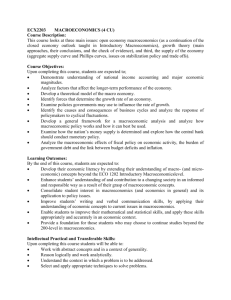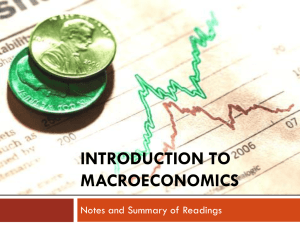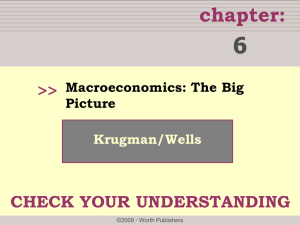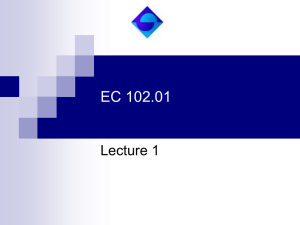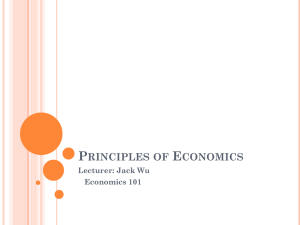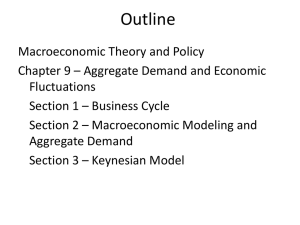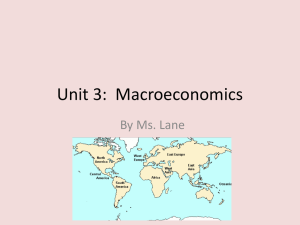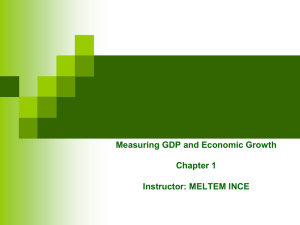lecture ppts in intro macroeconomics
advertisement
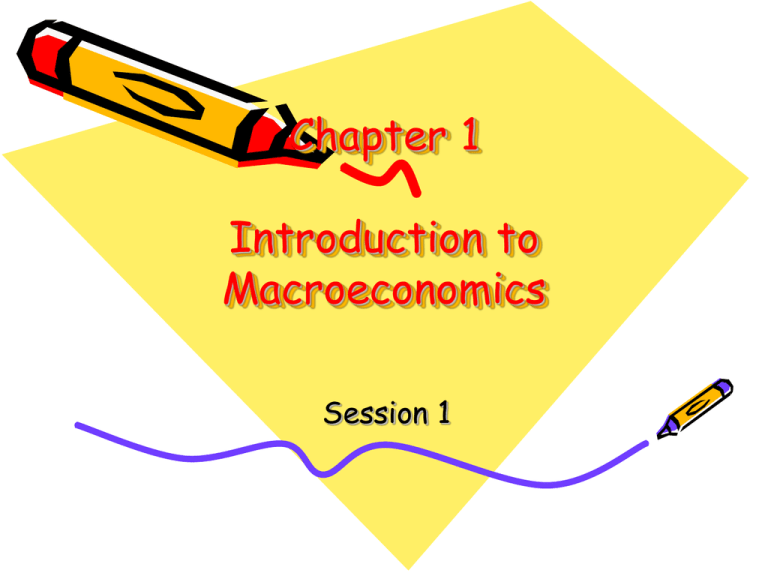
Chapter 1 Introduction to Macroeconomics Session 1 What Macroeconomics is About • Macroeconomics is the study of the structure and performance of national economies and of the policies that governments use to try to affect economic performance. What is macroeconomics? The study of the economy as a whole, and the variables that control the macro-economy. The study of government policy meant to control and stabilize the economy over time, that is, to reduce fluctuations in the economy. The study of monetary policy, fiscal policy, and supplyside economics. Who introduced macroeconomics, and what was its major objective? John Maynard Keynes, an English economist, hence macroeconomics is also referred to as Keynesianism. Keynes argued that by itself the market is unable to generate enough savings (capital) to sustain investment at full employment levels; and that this could be achieved only with the periodic sharp increase in government spending. What is Macroeconomics • Macroeconomics examines economies at the aggregate (international, national, regional) level. • Some aspects of macroeconomics are about comparing two aggregate economies at the same time. Why study the economy at the aggregate level? • Much of macroeconomics is concerned with policies such as money supply or tax policy which is national in scope. • Equilibrium effects means that outcomes are different when we consider the economy in aggregate. • There are certain phenomenon like economic growth and business cycles which affect the aggregate economy equally. . Macroeconomics 7 Deals with the classic issues in economics: • Unemployment • Inflation • National Output & National Income • Population Growth • Economic Growth • Money & Banking • Output • Business Cycle Macro Economic Goals • • • • • • • The goal of economic growth The Goal of Low Unemployment The Goal of Low Inflation Price Stability Complementary and Conflicting Goals A rise in average living standards Sustainable position on the balance of payments • Sound government finances 2. Macroeconomic Goals Complementary and Conflicting Goals • Complementary Goals – Low unemployment and high economic growth • Conflicting Goals – Low unemployment and low inflation • The Main Problems of Managing the Macroeconomy Inaccurate economic data: All of the main macroeconomic indicators are subject to a margin of error. They rely on statistical data collected from tax returns and surveys and data is often revised many months after its first release • Conflicting policy objectives: A policy of stimulating aggregate demand may reduce unemployment in the short term but initiate a period of higher inflation and exacerbate the current account of the balance of payments. Choices have to be made between objectives i.e. there exist trade-offs between them • Selecting the right policy instrument: Each macroeconomic objective requires a separate policy instrument: The usual ‘rule of thumb’ is that one main policy instrument should be assigned to one policy objective. So, for example, interest rates might be assigned as the main instrument for keeping control of inflation, whilst fiscal policy instruments such as changes to the tax system might be allocated to achieving some supply-side objectives such as increasing the labour supply, boosting incentives, raising investment and increasing productivity. There are quite deep-rooted disagreements between some economists (who belong to different ‘schools of thought’) as to which policies are most effective to meet a certain objective • Uncertain time lags when running a policy: Changes in economic policies are subject to uncertain time lags e.g. a change in interest rates is estimated to take some 18-24 months to work its way fully through the whole economy to filter through to a change in prices. The length of the time lags can change over the years as the reactions of consumers and businesses to policy measures alters • External shocks: Unexpected external shocks to economy such as the events surrounding Sept 11th 2001 or unexpected volatility in exchange rates and commodity prices can upset economic forecasts and take the economy some distance from the expected path. The Government might under-estimate or exaggerate the potential impact of an economic shock to either the demand or supply-side of the economy and therefore apply too little or too much of a policy response. The main instruments of Macro Economic Policy • Fiscal Policy – Fiscal policy involves the use of government spending, taxation and borrowing to influence both the pattern of economic activity and also the level and growth of aggregate demand, output and employment. • Monetary Policy – Monetary policy involves the use of interest rates to control the level and rate of growth of aggregate demand in the economy. Major Macroeconomic Variables • Economic output Short-run business fluctuations Long-run economic growth • Unemployment and Employment • Inflation Key Macroeconomic Variables • Interest rates • Government budget balances and finance • International trade balances and finance • Productivity • Macroeconomics & Microeconomics Microeconomics – Decisions of individual units • No matter how large • Macroeconomics – Behavior of entire economies • No matter how small – Economic aggregates 14 • Macroeconomics & Microeconomics Aggregation – Combine many individual markets – Into one overall market • Composition of demand & supply – In various markets – Important for microeconomics issues – Not important for macroeconomics issues • During economic fluctuations – Markets – move up or down together 15 • Macroeconomics & Microeconomics Macroeconomics – Assume most details • Resource allocation & income distribution • Relatively unimportant • Microeconomics – Ignore macroeconomics issues – Focus – individual markets • Allocate resources • Distribute income 16 Supply & Demand in Macroeconomics • Aggregate demand curve – Quantity of domestic product – demanded – Each possible value of price level • Aggregate supply curve – Quantity of domestic product – supplied – Each possible value of price level 17 Figure 1 D1 S D Price Price Two interpretations of a shift in the demand curve S D0 A P1 E E P0 P0 S S D1 D 0 Q0 Quantity (a) D0 0 Quantity (b) 18 Supply & Demand in Macroeconomics • Inflation – Sustained increase in price level – Outward shift of aggregate demand curve • Recession – period of time – Total output – declines • Production falls • People lose jobs – Leftward shift of aggregate demand curve 19 Figure 2 An economy slipping into a recession S D0 D2 Price Level E P0 B P2 S D2 0 Q2 D0 Q0 Domestic Product 20 Supply & Demand in Macroeconomics • Macroeconomists study – Inflation – Recession & unemployment – Economic growth Figure 3 Economic growth D1 S0 D0 S1 Price Level C E D1 S0 0 D0 S1 Q0 Q1 Domestic Product 22 Gross Domestic Product • Gross domestic product (GDP) – Sum: money values – All final goods & services • Produced - domestic economy • Sold – organized markets – Specified period of time • Usually a year 23 Gross Domestic Product • Nominal GDP – GDP in current dollars – Value outputs – current prices • Real GDP – Value outputs of different years • Common prices 24 Gross Domestic Product • GDP - particular year – Add up money value of things – Goods & services • Produced within the year – Final goods & services – Production: geographic boundaries of U.S. – Organized markets 25 Gross Domestic Product • Final goods and services – Purchased by their ultimate users • Intermediate good - purchased – For resale – For use in producing another good 26 Gross Domestic Product • Limitations of GDP – – – – Not measure: nation’s economic well-being Includes only market activity Places no value on leisure Ecological costs • Not deducted from GDP 27 microeconomics Examines the functioning of individual industries and the behavior of individual decision-making units—firms and households. macroeconomics Deals with the economy as a whole. Macroeconomics focuses on the determinants of total national income, deals with aggregates such as aggregate consumption and investment, and looks at the overall level of prices instead of individual prices. aggregate behavior The behavior of all households and firms together. sticky prices Prices that do not always adjust rapidly to maintain equality between quantity supplied and quantity demanded. 28 of Macroeconomic Concerns Output Growth business cycle The cycle of short-term ups and downs in the economy. aggregate output The total quantity of goods and services produced in an economy in a given period. recession A period during which aggregate output declines. Conventionally, a period in which aggregate output declines for two consecutive quarters. depression A prolonged and deep recession. 29 of 24 Macroeconomic Concerns Output Growth expansion or boom The period in the business cycle from a trough up to a peak during which output and employment grow. contraction, recession, or slump The period in the business cycle from a peak down to a trough during which output and employment fall. 30 of 24 Macroeconomic Concerns Output Growth FIGURE 20.1 A Typical Business Cycle In this business cycle, the economy is expanding as it moves through point A from the trough to the peak. When the economy moves from a peak down to a trough, through point B, the economy is in recession. 31 of 24 Macroeconomic Concerns Output Growth FIGURE 20.2 U.S. Aggregate Output (Real GDP), 1900–2007 The periods of the Great Depression and World Wars I and II show the largest fluctuations in aggregate output. 32 of 24 Macroeconomic Concerns Unemployment unemployment rate The percentage of the labor force that is unemployed. Inflation and Deflation inflation An increase in the overall price level. hyperinflation A period of very rapid increases in the overall price level. deflation A decrease in the overall price level. 33 of 24 The Components of the Macro economy Macroeconomics focuses on four groups. To see the big picture, it is helpful to divide the participants in the economy into four broad groups: (1) households, (2) firms, (3) the government, and (4) the rest of the world. 34 of 24 The Components of the Macroeconomy The Circular Flow Diagram circular flow A diagram showing the income received and payments made by each sector of the economy. transfer payments Cash payments made by the government to people who do not supply goods, services, or labor in exchange for these payments. They include Social Security benefits, veterans’ benefits, and welfare payments. 35 of 24 The Components of the Macroeconomy The Circular Flow Diagram Households receive income from firms and the government, purchase goods and services from firms, and pay taxes to the government. They also purchase foreign-made goods and services (imports). Firms receive payments from households and the government for goods and services; they pay wages, dividends, interest, and rents to households and taxes to the government. The government receives taxes from firms and households, pays firms and households for goods and services— including wages to government workers—and pays interest and transfers to households. Finally, people in other countries purchase goods and services produced domestically (exports). Note: Although not shown in this diagram, firms and governments also purchase imports. 36 of 24 The Components of the Macroeconomy The Three Market Arenas Another way of looking at the ways households, firms, the government, and the rest of the world relate to each other is to consider the markets in which they interact. We divide the markets into three broad arenas: (1) the goods-and-services market, (2) the labor market, and (3) the money (financial) market. 37 of 24 The Components of the Macroeconomy The Three Market Arenas Goods-and-Services Market Firms supply to the goods-and-services market. Households, the government, and firms demand from this market. Labor Market In this market, households supply labor and firms and the government demand labor. 38 of 24 The Components of the Macroeconomy The Three Market Arenas Money Market Households supply funds to this market in the expectation of earning income in the form of dividends on stocks and interest on bonds. Firms, the government, and the rest of the world also engage in borrowing and lending which is coordinated by financial institutions. 39 of 24 The Components of the Macroeconomy The Three Market Arenas Money Market Treasury bonds, notes, and bills Promissory notes issued by the federal government when it borrows money. corporate bonds Promissory notes issued by firms when they borrow money. shares of stock Financial instruments that give to the holder a share in the firm’s ownership and therefore the right to share in the firm’s profits. dividends The portion of a firm’s profits that the firm pays out each period to its shareholders. 40 of 24 The Components of the Macroeconomy The Role of the Government in the Macroeconomy fiscal policy Government policies concerning taxes and spending. monetary policy The tools used by the Federal Reserve to control the quantity of money, which in turn affects interest rates. 41 of 24 John Maynard Keynes Much of the framework of modern macroeconomics comes from the works of John Maynard Keynes, whose General Theory of Employment, Interest and Money was published in 1936. 42 of 24 Issues Addressed by Macroeconomists • What determines a nation’s long-run economic growth? • What causes a nation’s economic activity to fluctuate? • What causes unemployment? Issues Addressed by Macroeconomists (continued) • What causes prices to rise? • How does being a part of a global economic system affect nations’ economies? • Can government policies be used to improve economic performance? Long-Run Economic Growth – Rich nations have experienced extended periods of rapid economic growth. – Poor nations either have never experienced them or economic growth was offset by economic decline. Increased Output • Total output is increasing because of increasing population, i.e. the number of available workers. • Increasing average labour productivity: the amount of output produced per unit of labour input. Rates of Growth of Output • Rates of growth of output (or output per worker) are determined by: – rates of saving and investment; – rates of technological change; – rates of change in other factors. Business Cycles • Business cycles are short-run contractions and expansions of economic activity Recessions • Recession is the downward phase of a business cycle when national output is falling or growing slowly. – Hard times for many people – A major political concern Unemployment • Recessions are usually accompanied by high unemployment: the number of people who are available for work and are actively seeking it but cannot find jobs. Unemployed Unemployme nt Rate 100% Labour Force Inflation • When prices of most goods and services are rising over time it is inflation. When they are falling it is deflation. • The inflation rate is the percentage increase in the average level of prices. Effects of Inflation • When the inflation rate reaches an extremely high level the economy tends to function poorly. The purchasing power of money erodes quickly, which forces people to spend their money as soon as they receive it. The International Economy • An economy which has extensive trading and financial relationships with other national economies is an open economy. An economy with no relationships is a closed economy. The International Economy (continued) • International trade and borrowing relationships can transmit business cycles from country to country. Exports and Imports Indian exports are goods and services produced in India and consumed abroad. Indian imports are goods and services produced abroad and consumed in India Trade Imbalances • Trade imbalances (trade surplus and deficit) affect output and employment. – Trade surplus: exports exceed imports. – Trade deficit: imports exceed exports. The Exchange Rate • The trade balance is affected by the exchange rate: the amount of Indian Rupee that can be purchased with a unit of foreign currency. Macroeconomic Policy • A nation’s economic performance depends on: – – – – – natural and human resources; capital stock; technology economic choices made by citizens; macroeconomic policies of the government. Macroeconomic Policy (continued) • Macroeconomic policies: – Fiscal policy: government spending and taxation at different government levels. – Monetary policy: the central bank’s control of short-term interest rates and the money supply. Budget Deficits • The economy is affected when there are large budget deficits: the excess of government spending over tax collection. Aggregation • Macroeconomists ignore distinctions between individual product markets and focus on national totals. • The process of summing individual economic variables to obtain economywide totals is called aggregation. What Macroeconomists Do • • • • Macroeconomic forecasting Macroeconomic analysis Macroeconomic research Data development Macroeconomic Forecasting • Macroeconomic forecasting – prediction of future economic trends - has some success in the short run. In the long run too many factors are highly uncertain. Macroeconomic Analysis • Macroeconomic analysis - analyzing and interpreting events as they happen – helps both private sector and public policymaking. Macroeconomic Research • Macroeconomic research - trying to understand the structure of the economy in general – forms the basis for macroeconomic analysis and forecasting. Economic Theory • Economic theory: a set of ideas about the economy to be organized in a logical framework. • Economic model: a simplified description of some aspects of the economy. Developing and Testing a Theory • State the research question. • Make provisional assumptions. • Work out the implications of the theory. • Conduct an empirical analysis. • Evaluate the results. Data Development • Macroeconomists use data to assess the state of the economy, make forecasts, analyze policy alternatives, and test theories. Data Development (continued) • Providers of data must: – Decide what types of data should be collected based on who is expected to use the data and how. – Ensure the measures of economic activity correspond to economic concepts. – Guarantee the confidentiality of data. Why Macroeconomists Disagree • A positive analysis examines the economic consequences of an economic policy, but it does not address its desirability. • A normative analysis tries to determine whether a certain economic policy should be used. Why Macroeconomists Disagree (continued) • Economists can disagree on normative issues because of differences in values. • Economists disagree on positive issues because of different schools of thought. The Classical Approach • The invisible hand of Economics: General welfare will be maximized (not the distribution of wealth) if: – there are free markets; – individuals act in their own best interest. The Classical Approach (continued) • To maintain markets’ equilibrium – the quantities demanded and supplied are equal: – Markets must function without impediments. – Wages and prices should be flexible. The Classical Approach (continued) • Thus, according to the classical approach, the government should have a limited role in the economy. The Keynesian Approach • Keynes (1936) assumed that wages and prices adjust slowly. • Thus, markets could be out of equilibrium for long periods of time and unemployment can persist. The Keynesian Approach (continued) • Therefore, according to the Keynesian approach, governments can take actions to alleviate unemployment. The Keynesian Approach (continued) • The government can purchase goods and services, thus increasing the demand for output and reducing unemployment. • Newly generated incomes would be spent and would raise employment even further. Evolution of the Classical-Keynesian Debate • After stagflation – high unemployment and high inflation – of the 1970s, a modernized classical approach reappeared. • Substantial communication and cross-pollination is taking place between the classical and the Keynesian approaches. Unified Approach to Macroeconomics • Individuals, firms and the government interact in goods, asset and labour markets. • The macroeconomic analysis is based on the analysis of individual behaviour. The Unified Approach (continued) • Keynesian and classical economists agree that in the long run prices and wages adjust to equilibrium levels. • The basic model will be used either with classical or Keynesian assumptions about flexibility of wages and prices in the short run. Importance of Macro Economics • Growing importance of macro economic issues • Persistence of Macroeconomic Problems • Growing Complexity of economic system • Need for Govt. intervention with the market system • Use of Macro Economics in Business Limitations • It ignores structural Changes • Aggregate are nor reality but a picture or approximation of reality • Some Economist consider macroeconomics only as an intellectual attraction without much of practical use. Such as J.R.Hicks. Global Economy GDP CPI IIP Emp US UK Euro Japan China 1.6 Q2-2013 1.3 -0.5 1.2 7.5 Q2-2013 Q2-2013 Q2-2013 Q2-2013 1.5 Aug2013 2.7 Aug2013 1.1 0.9 Aug2013 2.6 Aug2013 2.7 Aug2013 -1.5 -0.2 July2013 -2.1 July2013 Aug2013 10.4 Aug2013 7.3 Aug2013 7.7 June2013 12.0 Aug2013 4.1 4.1 Q2-2013 Updated on 07 October, 2013 Emp : Unemployment Rate Sept2013 Aug2013
